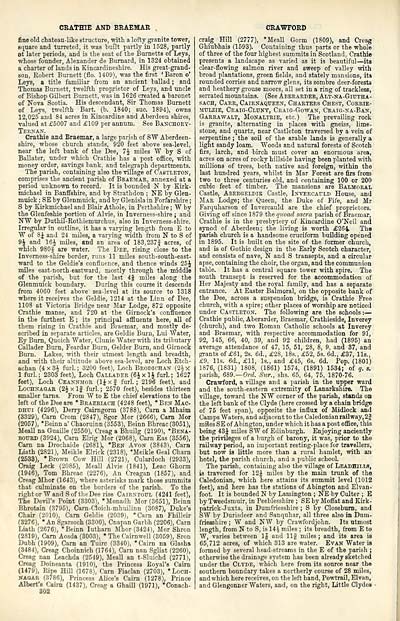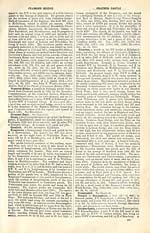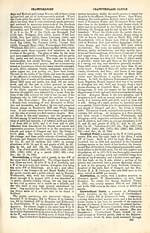Ordnance gazetteer of Scotland
(310) Page 302
Download files
Complete book:
Individual page:
Thumbnail gallery: Grid view | List view

CRATHIE AND BRAEMAR
fine old chateau-like structure, -with a lofty granite tower,
square and turreted, it was built partly in 1528, partly
ot later periods, and is the seat of the Burnetts of Leys,
whose founder, Alexander de Burnard, in 1324 obtained
a charter of lands in Kincardineshire. His great-grand-
son, Robert Burnett (flo. 1409), was the first 'Baron o'
Leys, a title familiar from an ancient ballad ; and
Thomas Burnett, twelfth proprietor of Leys, and uncle
of Bishop Gilbert Burnett, was in 1626 created a baronet
of Nora Scotia. His descendant, Sir Thomas Burnett
of Leys, twelfth Bart. (b. 1840; sue. 1894), owns
12,025 and 84 acres in Kincardine and Aberdeen shires,
valued at £5007 and £109 per annum. See Banchory-
Ternan.
Crathie and Braemar, a large parish of SW Aberdeen-
shire, whose church stands, 920 feet above sea-level,
near the left bank of the Dee, 7J miles W by S of
Ballater, under which Crathie has a post office, with
money order, savings bank, and telegraph departments.
The parish, containing also the village of Castleton,
comprises the ancient parish of Braemar, annexed at a
period unknown to record. It is bounded N by Kirk-
michael in Banffshire, and by Strathdon ; NE by Glen-
muick ; SE by Glenmuick, and by Glenisla in Forfarshire ;
S by Kirkmichael and Blair Athole, in Perthshire ; W by
t he G lenfeshie portion of Alvie, in Inverness-shire ; and
NW by Duthil-Rothiemurchus, also in Inverness-shire.
Irregular in outline, it has a varying length from E to
W of 8J and 24 miles, a varying width from N to S of
9J and 16J miles, and an area of 183,237J acres, of
which 980f are water. The Dee, rising close to the
Inverness-shire border, runs 11 miles south-south-east-
ward to the Geldie's confluence, and thence winds 25J
miles east-north-eastward, mostly through the middle
of the parish, but for the last 4g miles along the
Glenmuick boundary. During this course it descends
from 4060 feet above sea-level at its source to 1318
where it receives the Geldie, 1214 at the Linn of Dee,
1108 at Victoria Bridge near Mar Lodge, 872 opposite
Crathie manse, and 720 at the Girnock's confluence
in the furthest E ; its principal affluents here, all of
them rising in Crathie and Braemar, and mostly de-
scribed in separate articles, are Geldie Burn, Lui Water,
Ey Bum, Quoich Water, Clunie Water with its tributary
Callader Burn, Feardar Burn, Gelder Burn, and Girnock
Burn. Lakes, with their utmost length and breadth,
and with their altitude above sea-level, are Loch Etch-
achan (4 x 3J furl. ; 3200 feet), Loch Brodichan (2* x
1 furl. ; 2303 feet), Loch Callader (6J x 1 J furl. ; 1627
feet), Loch Ceannmor (1 J x f furl. ; 2196 feet), and
Lochnaqar (2J x 1 j furl. ; 2570 feet), besides thirteen
smaller tarns. From W to E the chief elevations to the
left of the Dee are *Braeriach (4248 feet), *Ben Mac-
dhtti (4296), Derry Cairngorm (3788), Cam a Mhaim
(3329), Cam Crom (2847), Sgor Mor (2666), Cam Mor
(2057), *Beinn a' Chaoruinn (3553), Beinn Bhreac(3051),
Meall na Guaille (2550), Creag a Bhuilg (2190), *Bena-
botjrd (3924), Cam Elrig Mor (2068), Cam Eas (3556),
Cam na Drochaide (2681), 'Ben Avon (3843^, Cam
Liath (2821), Meikle Elrick (2318), "Meikle Geal Charn
(2533), "Brown Cow Hill (2721), Culardoch (2933),
Craig Leek (2085), Meall Alvie (1841), Leac Ghorm
(1946), Tom Bhreac (2276), An Creagan (1857), and
Creag Mhor (1643), where asterisks mark those summits
that culminate on the borders of the parish. To the
right or Wand S of the Dee rise Cajrntottl (4241 feet),
The Devil's Point (3303), *Monadh Mor (3651), Beinn
Bhrotain (3795), Cara-Cloich-mhuilinn (3087), Duke's
Chair (2010), Cam Geldie (2039), *Cara an Fhilleir
(3276), *An Sgarsoch (3300), Cnapan Garbh (2206), Cam
Liath (2676), v Beinn Iutbam Mhor (3424), Mor Shron
(2819), Cam Aosda (3003), * The Caimwell (3059), Sron
Dubh (1909), Cam an Tuirc (3340), "Cairn na Glasha
(3484), Creag Choinnich (1764), Cam nan Sgliat (2260),
Creag nan Leachda (2549), Meall an t-Sluichd (2771),
Creag Doineanta (1910), the Princess Royal's Caim
(1479), Ripe Hill (1678), Cam Fiaclan (2703), *Loch-
naoar (3786), Princess Alice's Caim (1278), Prince
Albert's Caim (1437), Creag a Ghaill (1971), "Conach-
302
CRAWFORD
craig Hill (2777), *Meall Gorm (1809), and Creag
Ghiubhais (1593). Containing thus parts or the whole
of three of the four highest summits in Scotland, Crathie
presents a landscape as varied as it is beautiful — its
clear-flowing salmon river and sweep of valley with
broad plantations, green fields, and stately mansions, its
rounded corries and narrow glens, its sombre deer-forests
and heathery grouse moors, all set in a ring of trackless,
serrated mountains. (See Aberarder, Alt-na-Gtutha-
sach, Carr, Cairnaqtteen, Charters Chest, Corrie-
mtjlzte, Craiq-Cluny, Craig-Gowan, Craig-na-Ban,
Garrawalt, Monaltrie, etc.) The prevailing rock
is granite, alternating in places with gneiss, lime-
stone, and quartz, near Castleton traversed by a vein of
serpentine ; the soil of the arable lands is generally a
light sandy loam. Woods and natural forests of Scotch
firs, larch, and birch must cover an enormous area,
acres on acres of rocky hillside having been planted with
millions of trees, both native and foreign, within the
last hundred years, whilst in Mar Forest are firs from
two_ to three centuries old, and containing 100 or 200
cubic feet of timber. The mansions are Balmoral
Castle, Abergeldie Castle, Invercatjld House, and
Mar Lodge; the Queen, the Duke of Fife, and Mr
Farquharson of Invercauld are the chief proprietors.
Giving off since 1879 the quoad sacra parish of Braemar,
Crathie is in the presbytery of Kincardine O'Neil and
synod of Aberdeen; the living is worth £264> The
parish church is a handsome cruciform building opened
in 1895. It is built on the site of the former church,
and is of Gothic design in the Early Scotch character,
and consists of nave, N and S transepts, and a circular
apse, containing the choir, the organ, and the communion
table. It has a central square tower with spire. The
south transept is reserved for the accommodation of
Her Majesty and the royal family, and has a separate
entrance. At Easter Balmoral, on the opposite bank of
the Dee, across a suspension bridge, is Crathie Free
church, with a spire; other places of worship are noticed
under Castleton. The following are the schools : —
Crathie public, Aberarder, Braemar, Crathieside, Inverey
(church), and two Roman Catholic schools at Inverey
and Braemar, with respective accommodation for 91,
92, 145, 66, 40, 39, and 92 children, had (1895) an
average attendance of 47, 15, 51, 28, 8, 9, and 87, and
grants of £61, 2s. 6d., £28, 18s., £52, 5s. 6d., £37, lis.,
£9, lis. 6d., £11, Is., and £45, 6s. 6d. Pop. (1801)
1876, (1831) 1808, (1861) 1574, (1891) 1534; of q. s.
parish, 689.— Ord. Sur., shs. 65, 64, 75, 1870-76.
Crawford, a village and a parish in the upper ward
and the south-eastern extremity of Lanarkshire. The
village, toward the NW corner of the parish, stands od
the left bank of the Clyde (here crossed by a chain bridge
of 75 feet span), opposite the influx of Midlock and
Camps Waters, and adjacentto the Caledonian railway, 2J
miles SE of Abington, under which it has a post office, this
being 43J miles SW of Edinburgh. Enjoying anciently
the privileges of a burgh of barony, it was, prior to the
railway period, an important resting-place for travellers,
but now is little more than a rural hamlet, with an
hotel, the parish church, and a public school.
The parish, containing also the village of Leadhills,
is traversed for 12J miles by the main trunk of the
Caledonian, which here attains its summit level (1012
feet), and here has the stations of Abington and Elvan-
foot. It is bounded N by Lamington ; NE by Culter ; E
by Tweedsmuir, in Peeblesshire ; SE by Moffat and Kirk-
patrick-Juxta, in Dumfriesshire ; S by Closeburn, and
SW by Durisdeer and Sanquhar, all three also in Dum-
friesshire ; W and NW by Crawfordjohn. Its utmost
length, from N to S, is 14 i miles ; its breadth, from E to
W, varies between 1| and 11 g mileB ; and its area is
65,712 acres, of which 313 are water. Evan Water is
formed by several head-streams in the E of the parish ;
otherwise the drainage system has been already sketched
under the Clyde, which here from its source near the
southern boundary takes a northerly course of 28 miles,
and which here receives, on the left hand, Powtrail, El van,
and Glengonner Waters, and, on the right, Little Clydcs
fine old chateau-like structure, -with a lofty granite tower,
square and turreted, it was built partly in 1528, partly
ot later periods, and is the seat of the Burnetts of Leys,
whose founder, Alexander de Burnard, in 1324 obtained
a charter of lands in Kincardineshire. His great-grand-
son, Robert Burnett (flo. 1409), was the first 'Baron o'
Leys, a title familiar from an ancient ballad ; and
Thomas Burnett, twelfth proprietor of Leys, and uncle
of Bishop Gilbert Burnett, was in 1626 created a baronet
of Nora Scotia. His descendant, Sir Thomas Burnett
of Leys, twelfth Bart. (b. 1840; sue. 1894), owns
12,025 and 84 acres in Kincardine and Aberdeen shires,
valued at £5007 and £109 per annum. See Banchory-
Ternan.
Crathie and Braemar, a large parish of SW Aberdeen-
shire, whose church stands, 920 feet above sea-level,
near the left bank of the Dee, 7J miles W by S of
Ballater, under which Crathie has a post office, with
money order, savings bank, and telegraph departments.
The parish, containing also the village of Castleton,
comprises the ancient parish of Braemar, annexed at a
period unknown to record. It is bounded N by Kirk-
michael in Banffshire, and by Strathdon ; NE by Glen-
muick ; SE by Glenmuick, and by Glenisla in Forfarshire ;
S by Kirkmichael and Blair Athole, in Perthshire ; W by
t he G lenfeshie portion of Alvie, in Inverness-shire ; and
NW by Duthil-Rothiemurchus, also in Inverness-shire.
Irregular in outline, it has a varying length from E to
W of 8J and 24 miles, a varying width from N to S of
9J and 16J miles, and an area of 183,237J acres, of
which 980f are water. The Dee, rising close to the
Inverness-shire border, runs 11 miles south-south-east-
ward to the Geldie's confluence, and thence winds 25J
miles east-north-eastward, mostly through the middle
of the parish, but for the last 4g miles along the
Glenmuick boundary. During this course it descends
from 4060 feet above sea-level at its source to 1318
where it receives the Geldie, 1214 at the Linn of Dee,
1108 at Victoria Bridge near Mar Lodge, 872 opposite
Crathie manse, and 720 at the Girnock's confluence
in the furthest E ; its principal affluents here, all of
them rising in Crathie and Braemar, and mostly de-
scribed in separate articles, are Geldie Burn, Lui Water,
Ey Bum, Quoich Water, Clunie Water with its tributary
Callader Burn, Feardar Burn, Gelder Burn, and Girnock
Burn. Lakes, with their utmost length and breadth,
and with their altitude above sea-level, are Loch Etch-
achan (4 x 3J furl. ; 3200 feet), Loch Brodichan (2* x
1 furl. ; 2303 feet), Loch Callader (6J x 1 J furl. ; 1627
feet), Loch Ceannmor (1 J x f furl. ; 2196 feet), and
Lochnaqar (2J x 1 j furl. ; 2570 feet), besides thirteen
smaller tarns. From W to E the chief elevations to the
left of the Dee are *Braeriach (4248 feet), *Ben Mac-
dhtti (4296), Derry Cairngorm (3788), Cam a Mhaim
(3329), Cam Crom (2847), Sgor Mor (2666), Cam Mor
(2057), *Beinn a' Chaoruinn (3553), Beinn Bhreac(3051),
Meall na Guaille (2550), Creag a Bhuilg (2190), *Bena-
botjrd (3924), Cam Elrig Mor (2068), Cam Eas (3556),
Cam na Drochaide (2681), 'Ben Avon (3843^, Cam
Liath (2821), Meikle Elrick (2318), "Meikle Geal Charn
(2533), "Brown Cow Hill (2721), Culardoch (2933),
Craig Leek (2085), Meall Alvie (1841), Leac Ghorm
(1946), Tom Bhreac (2276), An Creagan (1857), and
Creag Mhor (1643), where asterisks mark those summits
that culminate on the borders of the parish. To the
right or Wand S of the Dee rise Cajrntottl (4241 feet),
The Devil's Point (3303), *Monadh Mor (3651), Beinn
Bhrotain (3795), Cara-Cloich-mhuilinn (3087), Duke's
Chair (2010), Cam Geldie (2039), *Cara an Fhilleir
(3276), *An Sgarsoch (3300), Cnapan Garbh (2206), Cam
Liath (2676), v Beinn Iutbam Mhor (3424), Mor Shron
(2819), Cam Aosda (3003), * The Caimwell (3059), Sron
Dubh (1909), Cam an Tuirc (3340), "Cairn na Glasha
(3484), Creag Choinnich (1764), Cam nan Sgliat (2260),
Creag nan Leachda (2549), Meall an t-Sluichd (2771),
Creag Doineanta (1910), the Princess Royal's Caim
(1479), Ripe Hill (1678), Cam Fiaclan (2703), *Loch-
naoar (3786), Princess Alice's Caim (1278), Prince
Albert's Caim (1437), Creag a Ghaill (1971), "Conach-
302
CRAWFORD
craig Hill (2777), *Meall Gorm (1809), and Creag
Ghiubhais (1593). Containing thus parts or the whole
of three of the four highest summits in Scotland, Crathie
presents a landscape as varied as it is beautiful — its
clear-flowing salmon river and sweep of valley with
broad plantations, green fields, and stately mansions, its
rounded corries and narrow glens, its sombre deer-forests
and heathery grouse moors, all set in a ring of trackless,
serrated mountains. (See Aberarder, Alt-na-Gtutha-
sach, Carr, Cairnaqtteen, Charters Chest, Corrie-
mtjlzte, Craiq-Cluny, Craig-Gowan, Craig-na-Ban,
Garrawalt, Monaltrie, etc.) The prevailing rock
is granite, alternating in places with gneiss, lime-
stone, and quartz, near Castleton traversed by a vein of
serpentine ; the soil of the arable lands is generally a
light sandy loam. Woods and natural forests of Scotch
firs, larch, and birch must cover an enormous area,
acres on acres of rocky hillside having been planted with
millions of trees, both native and foreign, within the
last hundred years, whilst in Mar Forest are firs from
two_ to three centuries old, and containing 100 or 200
cubic feet of timber. The mansions are Balmoral
Castle, Abergeldie Castle, Invercatjld House, and
Mar Lodge; the Queen, the Duke of Fife, and Mr
Farquharson of Invercauld are the chief proprietors.
Giving off since 1879 the quoad sacra parish of Braemar,
Crathie is in the presbytery of Kincardine O'Neil and
synod of Aberdeen; the living is worth £264> The
parish church is a handsome cruciform building opened
in 1895. It is built on the site of the former church,
and is of Gothic design in the Early Scotch character,
and consists of nave, N and S transepts, and a circular
apse, containing the choir, the organ, and the communion
table. It has a central square tower with spire. The
south transept is reserved for the accommodation of
Her Majesty and the royal family, and has a separate
entrance. At Easter Balmoral, on the opposite bank of
the Dee, across a suspension bridge, is Crathie Free
church, with a spire; other places of worship are noticed
under Castleton. The following are the schools : —
Crathie public, Aberarder, Braemar, Crathieside, Inverey
(church), and two Roman Catholic schools at Inverey
and Braemar, with respective accommodation for 91,
92, 145, 66, 40, 39, and 92 children, had (1895) an
average attendance of 47, 15, 51, 28, 8, 9, and 87, and
grants of £61, 2s. 6d., £28, 18s., £52, 5s. 6d., £37, lis.,
£9, lis. 6d., £11, Is., and £45, 6s. 6d. Pop. (1801)
1876, (1831) 1808, (1861) 1574, (1891) 1534; of q. s.
parish, 689.— Ord. Sur., shs. 65, 64, 75, 1870-76.
Crawford, a village and a parish in the upper ward
and the south-eastern extremity of Lanarkshire. The
village, toward the NW corner of the parish, stands od
the left bank of the Clyde (here crossed by a chain bridge
of 75 feet span), opposite the influx of Midlock and
Camps Waters, and adjacentto the Caledonian railway, 2J
miles SE of Abington, under which it has a post office, this
being 43J miles SW of Edinburgh. Enjoying anciently
the privileges of a burgh of barony, it was, prior to the
railway period, an important resting-place for travellers,
but now is little more than a rural hamlet, with an
hotel, the parish church, and a public school.
The parish, containing also the village of Leadhills,
is traversed for 12J miles by the main trunk of the
Caledonian, which here attains its summit level (1012
feet), and here has the stations of Abington and Elvan-
foot. It is bounded N by Lamington ; NE by Culter ; E
by Tweedsmuir, in Peeblesshire ; SE by Moffat and Kirk-
patrick-Juxta, in Dumfriesshire ; S by Closeburn, and
SW by Durisdeer and Sanquhar, all three also in Dum-
friesshire ; W and NW by Crawfordjohn. Its utmost
length, from N to S, is 14 i miles ; its breadth, from E to
W, varies between 1| and 11 g mileB ; and its area is
65,712 acres, of which 313 are water. Evan Water is
formed by several head-streams in the E of the parish ;
otherwise the drainage system has been already sketched
under the Clyde, which here from its source near the
southern boundary takes a northerly course of 28 miles,
and which here receives, on the left hand, Powtrail, El van,
and Glengonner Waters, and, on the right, Little Clydcs
Set display mode to: Large image | Transcription
Images and transcriptions on this page, including medium image downloads, may be used under the Creative Commons Attribution 4.0 International Licence unless otherwise stated. ![]()
| Gazetteers of Scotland, 1803-1901 > Ordnance gazetteer of Scotland > (310) Page 302 |
|---|
| Permanent URL | https://digital.nls.uk/97396966 |
|---|

